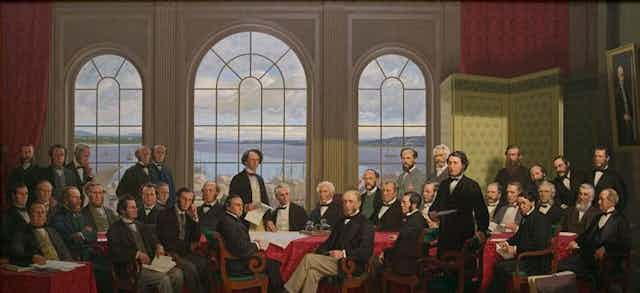Canadian federalism and provincial autonomy have entered the news cycle lately.
All three Prairie provinces recently announced their opposition to a federal gun buyback program.
Québec Premier François Legault also won a landslide re-election on a platform of asserting more provincial control over immigration and language laws.
And of course, Danielle Smith, Alberta’s new premier, was recently sworn in, elected by her party on a promise to introduce legislation called the Alberta sovereignty act.
Read more: How Danielle Smith won in Alberta and what it means for Canada
Critics have interpreted such moves as threats to national unity, with some predicting that provincial shows of independence will create an “extreme stress test” for Canada.
However, these events remind us why the Fathers of Confederation designed a separation of federal and provincial powers in the first place.
Preserving national unity
If handled correctly, the decentralized nature of Canadian federalism should accomplish exactly what it was designed to do: preserve national unity by respecting regional differences within Canada.
Historians’ interpretations of Confederation have changed over time. The old notion that Confederation made the provinces subordinate to Ottawa was popular in the mid-20th century, advocated by historians like Donald Creighton and Peter Waite.
But since the 1990s, Confederation historians like Paul Romney and Christopher Moore have placed the provinces at the centre of our founding moment. As Daniel Heidt summarized in a 2018 collection called Reconsidering Confederation:
“Nearly all groups, except for perhaps John A. Macdonald’s followers, demanded guarantees for local autonomy within Confederation.”
Despite some concessions to those who wanted a centralized union, including disallowance (federal veto over provincial laws, used very rarely in the past century) and residual powers (any issue not assigned to the provinces goes to the federal level), Canada’s founders designed a decentralized union wherein strong provincial powers would help to protect various regional interests.
The failed Province of Canada
To understand why decentralization is an important part of the Canadian system, it’s necessary to appreciate the failure of the Province of Canada (1841-1867). This merger of two colonies, Upper Canada (Ontario) and Lower Canada (Québec), created a centralized union with one shared legislature, as opposed to the federal union that would arise in 1867.

The united province was known for political deadlock and tenuous coalition governments that frequently collapsed over minor controversies and petty political manoeuvring. It failed because it was too centralized and left little space for regional differences.
To overcome these challenges, the Fathers of Confederation split the united province back into two provinces and carefully delineated federal versus provincial jurisdiction. Getting this balance right was critical to creating harmony in the new union and avoiding the problems of the united province.
As Liberal Leader George Brown stated in an 1865 speech:
“The questions that used to excite the most hostile feelings among us have been taken away from the general legislature (federal), and placed under the control of the local bodies (provincial).”
Division of powers
The British North America Act of 1867 encapsulated the founders’ deliberations, spelling out the division of federal and provincial powers in Sections 91 to 95.
Matters of shared interest across all provinces, such as military and currency, were assigned to the federal level. But issues like education, health care and immigration were placed squarely under provincial jurisdiction.

As my book Protestant Liberty explains, these issues were singled out for provincial control because they had often been politicized along religious lines (Protestant vs. Catholic), making national consensus impossible.
The founders had learned from the mistakes of the 1841 legislative union and instead devolved powers to more local bodies, allowing them to keep the peace at the national level.
A series of controversial provincial bills in the 1880s and 1890s, such as Québec’s land grant to the Society of Jesus (Jesuits) and Manitoba’s defunding of its Catholic schools, tested the durability of Canadian federalism.
Although the federal government was pressured to use disallowance to veto these controversial bills, federal leaders in both major parties recognized the right of provinces to make these decisions for themselves.
‘Co-equals’
By 1892, Canada’s highest court of appeal at the time (the Judicial Committee of the Privy Council) affirmed the principle that the provinces were not subordinate to Ottawa, but were, as historian John Belshaw summarized, “co-equal levels of government.”

There is room for debate about federal-provincial relations, and time will tell whether efforts like the Alberta sovereignty act will respect the delicate balance of powers upon which Canadian federalism has depended.
But Canadians shouldn’t be too quick to dismiss calls for provincial autonomy as a threat to national unity.
We are a vast country with considerable differences across regions. As the Fathers of Confederation recognized, our country can only remain united if we allow space for these regional differences to flourish, rather than trying to impose one-size-fits-all solutions.
With constitutional issues frequently making the news, now is the time for Canadians to refresh our understanding of the fundamental role of provincial powers, not as a threat to Confederation, but as a key ingredient that makes it work.

